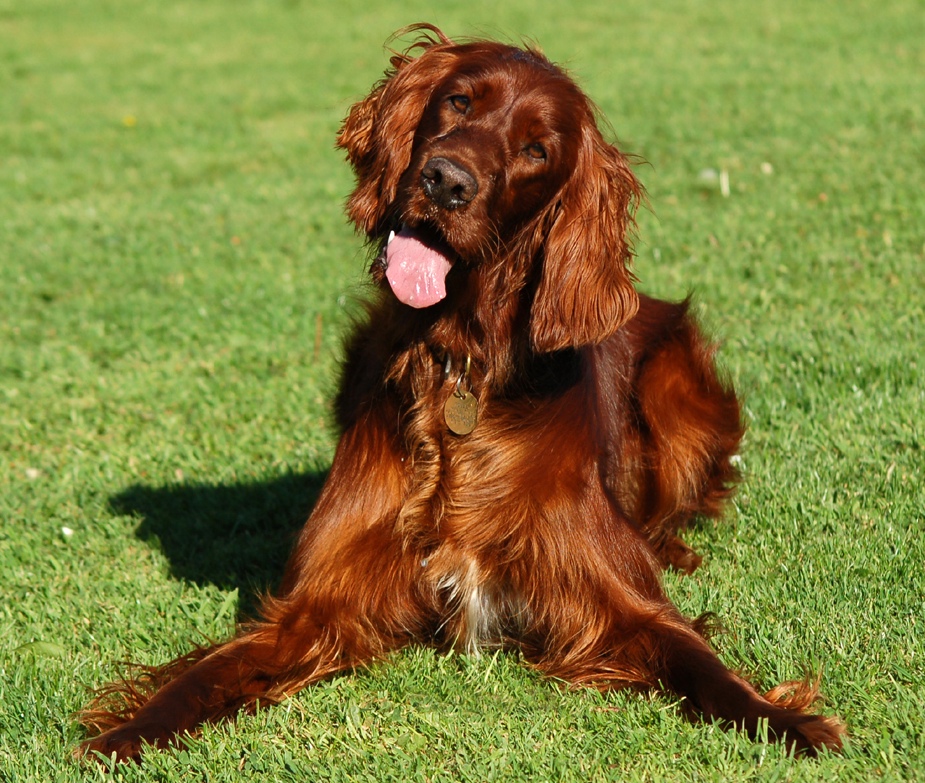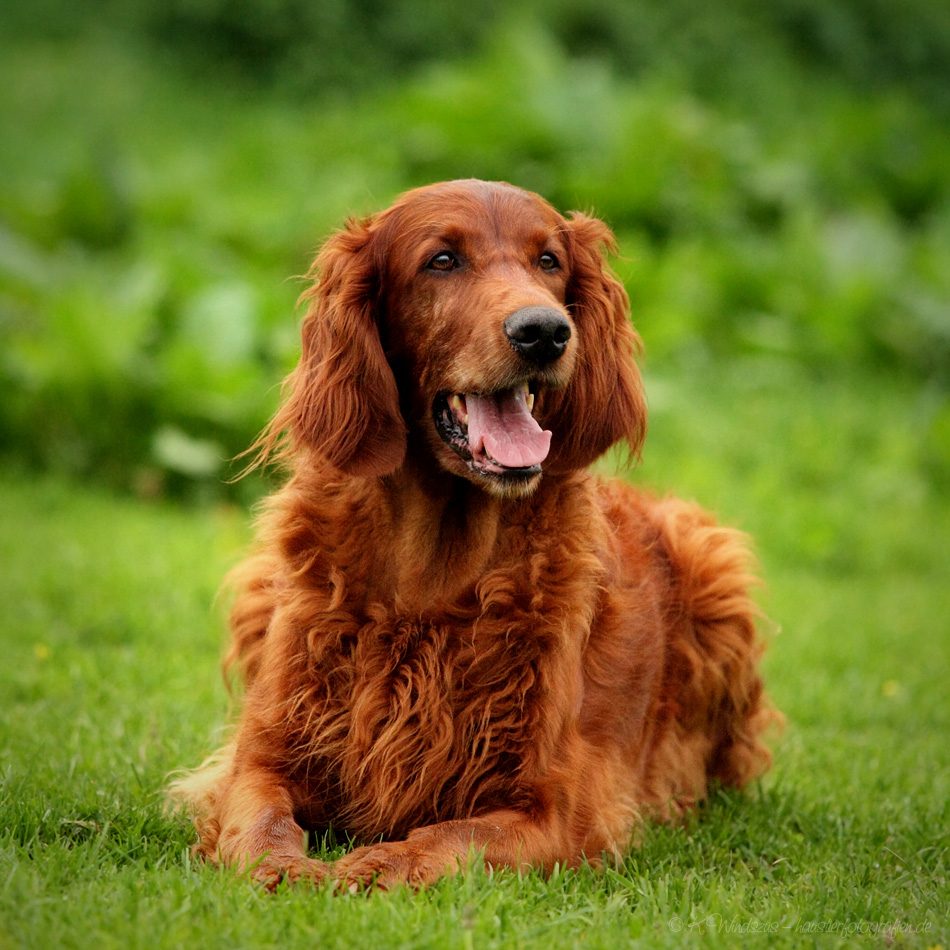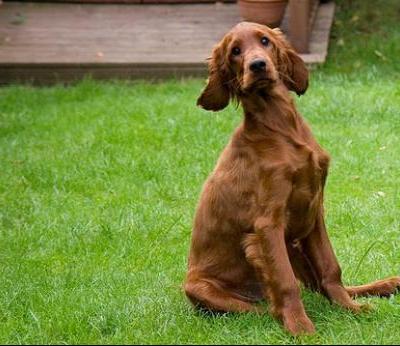
The Breed History
In the 18th century in Ireland, this breed most probably originated
from a mix of Pointer, Spaniel, English setter, and Gordon setter
breeds. The early specimens of these scent dogs were red and white,
but in the 19th century, they were progressively selected for the solid
red color. Disney's "Big Red" helped to propel this breed's popularity.
AKC registry began in 1878.
Breeding for Function
Bred to be a gun dog for both pointing and retrieving, they are now
most widely seen in conformation shows, obedience trials, and as a
household pet.
Physical Characteristics
Height at Withers: female 25" (63.5 cm), male 27" (69 cm)
Weight: females 60lb (27 kg), males 70 (32 kg).
Coat: The beautiful medium-length smooth, flat and glossy coat
has a rich mahogany or chestnut red color. Small white markings
are not faulted on feet or chest.
Longevity: 11-15 years.
Points of Conformation: A long, lean appearance with good bone,
finely chiseled muzzle, dark to medium brown colored eyes, ears
almost reaching the nose, well-defined stop and prominent occiput
characterize these dogs. These dogs have prominent flews and the
nose is pigmented black or brown. Their topline is gently inclined
downward to the rear, and the tail should almost reach the tarsus,
and is carried curving or straight nearly level with the back. They are
very deep-chested.
Recognized Behavior Issues and Traits
These dogs progress slowly but steadily during development of
their working skills, but excel at hunting tasks once fully trained.
They are gentle, loyal, outgoing dogs, with a characteristically stable
temperament. They are affectionate, have high energy levels and
while some are reserved, others may be a bit high strung. They are
not known to have well developed guarding instincts, instead they
may seem to want to "clown around". They require high levels of
exercise, and without adequate human contact, they may develop
boredom vices such as barking, digging or chewing. They are
moderate shedders and their grooming needs are average.
Normal Physiologic Variations
None reported
Drug Sensitivities
None reported
Inherited Diseases
Hip Dysplasia: Polygenically inherited trait causing degenerative
joint disease and hip arthritis. OFA reports 12.1% affected. Reported
at a frequency of 7.3% in the 2003 ISCA National Health Survey.
Elbow Dysplasia: Polygenically inherited trait causing elbow
arthritis. OFA reports 3.4% affected.
Patella Luxation: Polygenically inherited laxity of patellar
ligaments, causing luxation, lameness, and later degenerative
joint disease. Treat surgically if causing clinical signs. Too few
Irish Setters have been screened by OFA to determine an accurate
frequency.
Progressive Retinal Atrophy (PRA, RCD-1): Autosomal recessive,
early onset rod, cone dysplasia form of PRA with an onset of
25 days of age, and progressing to blindness by one year old. A
genetic test is available, revealing 7% carriers and 0.5% affected. A
late-onset, rcd-4 PRA also occurs in the breed with a average age
of onset of 10 years. A genetic test available.
Canine Leukocyte Adhesion Deficiency (CLAD): An autosomal
recessive, fatal immunodeficiency disease found in Irish setters.
Affected dogs present with severe recurrent infections, neutrophilia
and low body weight. A genetic test is available, showing 11%
testing as carriers in Germany, and 7.6% testing as carriers in
Australia. The frequency in the US population is not published.
Hypochondroplastic Dwarfism: A rare, autosomal recessive form
of dwarfism has been identified in the breed.
Hereditary Quadriplegia and Amblyopia: A rare, congenital,
autosomal recessive disorder causing inability to stand, tremor,
amblyopia with nystagmus, and seizures has been identified in the
breed.
Disease Predispositions
Allergic Dermatitis: Inhalant or food allergy. Presents with pruritis
and pyotraumatic dermatitis. Irish setters have a significantly
increased risk for atopy versus other breeds. Reported at a
frequency of 15.8% in the 2003 ISCA National Health Survey.
Gastric Dilatation-Volvulus (Bloat, GDV): Life-threatening
twisting of the stomach within the abdomen. Requires immediate
veterinary attention. Irish setters with the deepest thorax relative
to width had the greatest risk for GDV (8.45x odds ratio). A lifetime risk of 24.9% is reported, with 4.8% of all Irish Setters dying from
the condition. Reported at a frequency of 12.8% in the 2003 ISCA
National Health Survey.
Hypothyroidism: Inherited autoimmune thyroiditis. 12.6% positive
for thyroid autoantibodies based on testing at Michigan State
University. (Ave. for all breeds is 7.5%) Reported at a frequency of
20.7% in the 2003 ISCA National Health Survey. Dorn reports a
1.87x odds ratio versus other breeds.
Umbilical Hernias: Congenital opening of the abdominal wall at
the umbilicus. Correct with surgery if large. Reported at a frequency
of 10.3% in the 2003 ISCA National Health Survey.
Distichiasis: Abnormally placed eyelashes that irritate the cornea
and conjunctiva. Can cause secondary corneal ulceration. Identified
in 5.83% of Irish setters CERF-examined by veterinary ophthalmologists
between 2000-2005.
Persistent Pupillary Membranes: Strands of fetal remnant
connecting; iris to iris, cornea, lens, or involving sheets of tissue. The
later three forms can impair vision, and dogs affected with these
forms should not be bred. Identified in 5.56% of Irish Setters CERF
examined by veterinary ophthalmologists between 2000-2005.
Idiopathic Epilepsy: Inherited seizures can be generalized or
partial seizures. Control with anticonvulsant medications. Reported
at a frequency of 5.3% in the 2003 ISCA National Health Survey.
Unknown mode of inheritance.
Hypertrophic Osteodystrophy (HOD): Immune-mediated disorder
causing fever, and painful, swollen joints and bones in young Irish
Setters. Occurs mostly within 3-14 days post-vaccination. Age of
onset is 8-16 weeks. Reported 14.3x odds ratio versus other breeds.
Reported at a frequency of 5.0% in the 2003 ISCA National Health
Survey. Unknown mode of inheritance.
Urinary Incontinence: Spayed female Irish setters are over
represented compared with other breeds for urinary incontinence.
Reported at a frequency of 5.0% in the 2003 ISCA National Health
Survey.
Osteosarcoma: The Irish Setter is a breed with an increased
frequency of malignant osteosarcoma, usually in the long bones
of the limbs. Reported at a frequency of 4.6% in the 2003 ISCA
National Health Survey.
Cataracts: Anterior, posterior, and capsular intermediate and
punctate cataracts predominate in the breed. Identified in 3.89%
of Irish setters CERF-examined by veterinary ophthalmologists
between 2000-2005. Reported at a frequency of 5.3% in the 2003
ISCA National Health Survey. CERF does not recommend breeding
any Irish Setter with a cataract.
Entropion: Rolling in of the eyelid. Can cause corneal irritation.
Entropion is reported in 2.22% of Irish setters CERF-examined by
veterinary ophthalmologists between 2000-2005. Reported at a
frequency of 2.1% in the 2003 ISCA National Health Survey.
Gluten (Wheat) Sensitive Enteropathy: Irish setters can
demonstrate an inherited gluen sensitivity that produces poor
weight gain or weight loss, with or without diarrhea. Pathologically
the intestinal crypts become blunted, with increased intestinal
permeability. Reducing exposure to gluten (dietary cereal) will
minimize clinical signs. The mode of inheritance has not been
determined.
Seborrheic Dermatitis: Skin disorder presenting with greasy skin
and haircoat. Unknown mode of inheritance. Dorn reports a 2.51x
odds ratio versus other breeds.
Persistent Hyaloid Artery: Congenital defect resulting from
abnormalities in the development and regression of the hyaloid
artery. Identified in 1.11% of Irish Setters CERF examined by
veterinary ophthalmologists between 2000-2005.
IgA Deficiency: Inherited disorder seen in Irish setters causing
recurrent bacterial pneumonia, diarrhea, poor weight gain, skin
infections, allergies, and immune-mediated diseases.
Laryngeal Paralysis: Irish setters are a breed at increased risk
to develop geriatric laryngeal paralysis secondary to axonal
degeneration of the recurrent laryngeal nerve. Clinical signs are
exercise intolerance, inspiratory stridor, inspiratory dyspnea,
gagging, coughing and dysphonia.
Megaesophagus: Irish setters are identified as a breed at increased
risk of developing acquired megaesophagus. Causes include
peripheral neuropathy, laryngeal paralysis, acquired myasthenia
gravis, esophagitis, and gastric dilatation. Hypothyroidism is
not associated with megaesophagus. Clinical signs include
regurgitation, excess salivation, and aspiration pneumonia.
Degenerative Myelopathy (DM): Affected dogs show an insidious
onset of upper motor neuron (UMN) paraparesis at an average age of
11.4 years. The disease eventually progresses to severe tetraparesis.
Affected dogs have normal results on myelography, MRI, and CSF
analysis. Necropsy confirms the condition. Unknown mode of
inheritance. A direct genetic test for an autosomal recessive DM
susceptibility gene is available. All affected dogs are homozygous
for the gene, however, only a small percentage of homozygous dogs
develop DM. Clinical DM is reported at a prevalence of 0.68% in the
breed.
Acral lick Dermatitis, Brachygnathism, Cervical Vertebral
Instability, Color Dilution Alopecia, Cutaneous Asthenia,
Ectropion, Factor VIII Deficiency, Lissencephaly, Lupoid
Onychopathy, Narcolepsy, Optic Nerve Hypoplasia,
Osteochondrodysplasia, Perianal Fistula, Prognathism, Retained
Primary Teeth, Sebaceous Adenitis, Tricuspid Valve Dysplasia,
Vascular Ring Anomaly, and von Willebrand's Disease are
reported.
Isolated Case Studies
Patent Ductus Arteriosis (PDA): A right to left shunting PDA was
identified in a six-month-old, female Irish setter presented with a
two-month history of progressive hindlimb weakness and collapse
on exercise. Thoracic auscultation revealed a soft systolic murmur
and a split second heart sound.
Aortic Bulb/Valve Mineralization: Six of 20 affected dogs were
Irish setters in one study. The mineralization was visible radiographically,
but did not cause clinical signs.
Globoid Cell Leukodystrophy (Krabbe disease): A rare, autosomal
recessive lysosomal storage disease causing severe neurological
symptoms including seizures, hypotonia, blindness, and death in
young affected dogs was identified in a family of Irish setters. A
genetic test was developed for this cohort.
Genetic Tests
Tests of Genotype: Direct test for Canine Leukocyte Adhesion
Deficiency is available from HealthGene, Optigen and the Animal
Health Trust.
Direct test for Rcd-1 PRA is available from HealthGene, Optigen,
VetGen, and the Animal Health Trust.
Direct test for Rcd-4 PRA is available from the Animal Health Trust.
Direct test for a DM susceptability gene is available from OFA.
Tests of Phenotype: CHIC Certification: Required testing includes
hip radiographs, CERF eye examination or genetic test for PRA, and
thyroid profile including autoantibodies. Recommend elbow radiographs, patella evaluation, and cardiac examination.
Miscellaneous
- Breed name synonyms: Irishman, Irish Red Setter (historical),
Red Setter
- Registries: AKC, UKC, CKC, KCGB (Kennel Club of Great Britain),
ANKC(Australian National Kennel Club), NKC (National Kennel Club)
- AKC rank (year 2008): 69 (1,291 dogs registered)
- Internet resources: Irish Setter Club of America:
www.irishsetterclub.org
Irish setter Club of Canada: www.irishsettercanada.org
Irish Setter Association, England: www.isae.co.uk
National Red Setter Field Trial Club: www.nrsftc.com
Photo Gallery of Breed - Irish Setter - Dog Breed








 Animalia Life
Animalia Life